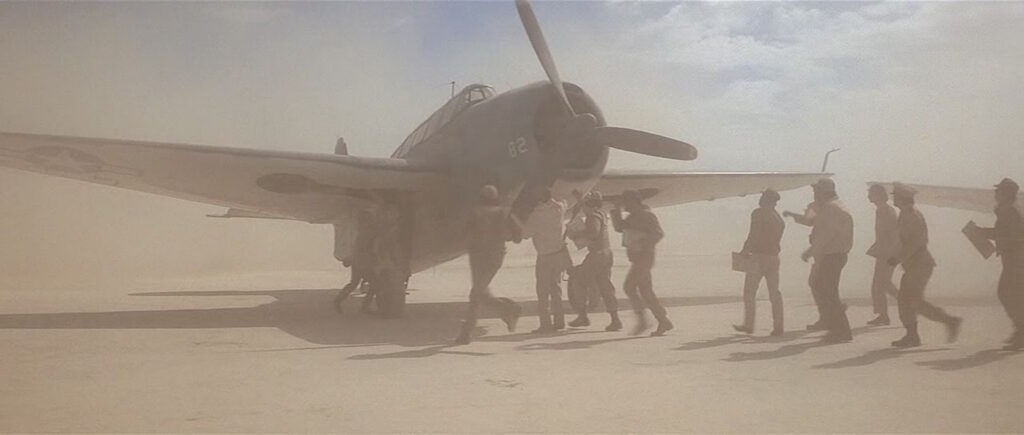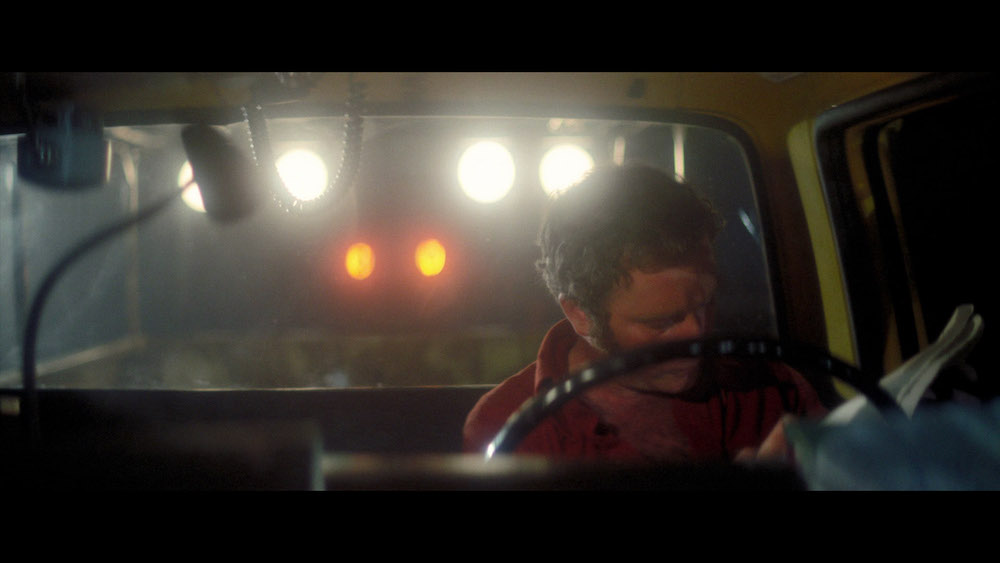
Yesterday, we took a look at a screenplay covering the famous Betty and Barney Hill UFO sighting. This, naturally, led to some discussion in the comments about the greatest UFO movie ever made, Close Encounters of the Third Kind.
I don’t need a reason to get me to watch Close Encounters again. Just a passing mention of it and my TV is already firing up because who doesn’t want to watch an iconic film about UFOs? While watching Spielberg’s near-perfect movie, I discovered something that shocked me. It’s something you don’t see anymore.
That something is: THE HEIGHTENED MOVIE MOMENT.
These are the moments in his movies that Spielberg basically writes himself. Or, if he doesn’t write them, he conceives of the sequence and tells the writer exactly what he wants. His screenwriters may write the scenes whole cloth where the government explains to Indiana Jones where the Ark of the Covenant might be. But the scene where Indiana is dragged by a truck before eventually overcoming the truck and beating up everyone on it? That’s all Spielberg.
Basically, what the heightened movie moment is, is a big moment that is meant to be captivating all on its own. Some people might call these “set pieces,” which they can be. But they’re more than that. They’re clever imaginative dramatized scenarios that pack a punch and are highly memorable.
Close Encounters is PACKED with these moments. And the more of these moments I saw, the more I wondered why this art has been abandoned.
I would argue that Spielberg himself doesn’t even do it anymore.
So what are these moments specifically?
The first occurs with some scientists showing up in a blustery dust storm in the middle of Mexico. They’re being frantically led somewhere, the suspense building as to where and what’s going on. Then they finally come around a bend and see that there are two dozen World War 2 planes just parked out in the desert, which we quickly learn all went missing during a mission over 30 years ago.
This is followed by a really smart scene where a plane nearly hits a UFO at night. But we’re never in the plane. We see this happen back in the air traffic control tower. Our featured controller helplessly watches as an object is hurtling towards one of the planes on his screen. Again, the suspense is high. Is it going to hit this plane and kill 200 people? Then, at the last second, it disappears.
In the very next scene, we get what is, probably, the most famous image from the movie, which is when the little child is woken up by all the flashing moving electronic toys, and then follows the noises out of the house.
That’s three scenes in a row that all work individually. In other words, you don’t need to know anything about what’s going on in the movie to enjoy the scenes. Because they’re creative, imaginative, heightened, suspenseful, and are constructed as if they are their own little story with a beginning, middle, and end.
Just a few scenes later, we get another famous heightened movie moment. This is the one where Roy, our protagonist, stops his car at night, another car pulls up behind him, but then that “car” rises up and hovers above him because it’s not a car, it’s a UFO. And this UFO then proceeds to magnetically lift up everything in his car.

What’s amazing is that all four of these great scenes happen BEFORE THE 20 MINUTE MARK.
Think about that for a second. Most writers can write 5-6 movies before writing one truly memorable heightened movie moment. Spielberg had four of them within twenty minutes!! That’s INSANE!!
After the movie cools down a little bit, we then get another classic heightened movie moment where hundreds of Indians chant a strange little hymn while praying in a remote city. We get Roy going nuts, collecting items around the neighborhood in a deranged state so he can build his rendition of the mountain he keeps seeing in his dreams. And then you get that amazing final set piece where the military makes official contact with the aliens.
When do we ever get sequences like this anymore? Truly creative thoughtful suspenseful moments that are so impactful that you talk about them with people immediately afterwards? You don’t. Most of today’s “heightened movie moments” are just superheroes fighting each other.
I suspect the problem is that the special effects technology has gotten so good that people don’t have to think creatively anymore. If you can do anything, you end up doing the obvious thing. Captain America vs. Captain America. Sure, it’s a fun scene. But does it require the thoughtful energy and creativity it takes to come up with any of the Close Encounters moments? Not even close. It’s the kind of scene that Chat GPT would come up with. There’s no heart, no soul.
As I started to think about Spielberg, I realized that he built his entire career on this. He built his career on a guy running from a boulder in a cave. He built his career on people wrestling back an angry caged velociraptor. He built his career on kids flying on bikes with an alien and a full moon in the background.
Every movie he used to make, he would think of those individual powerful movie moments that work all on their own. And we just don’t see that anymore. And, again, NOT EVEN SPIELBERG does it anymore. It’s like he’s forgotten what made him great.
I think you know where this is going.
I want you to start incorporating this secret old Spielbergian philosophy into your own scripts. Think about five magical moments that take advantage of your specific premise and then incorporate them into your script, even if it means building your narrative around them. Because if there’s anything today’s taught me, it’s that a script is worthless if it doesn’t have any memorable moments.
How do you achieve this?
I know that Spielberg did a ton of research in Close Encounters. He hired J. Allen Hynek, the number one UFO authority in the world at the time. And Hynek just bombarded Spielberg with all these crazy UFO stories he’d investigated.
Spielberg then took the ones he liked the best and he built little mini-movie scenes around them. Just like any artist should do, he took the root of the real-life experience and he looked for ways to make it more dramatic and impactful.
For example, when it comes to the famous scene of a UFO appearing above a car and turning everything in the car off, I suspect that Spielberg may have added the idea of the UFO first coming up behind them and looking like headlights. And then I’m guessing he added the magnetism pulling everything in the car upwards.
So look to real-life events in the subject matter you’re writing about to find the foundation of your heightened movie moments. For example, if you’re writing a plane crash movie, research 10 famous plane crashes. I’m sure you’ll find one you can use as the foundation for an amazing movie moment (which actually happened, by the way – John Gatins, who wrote “Flight,” heard about a plane that got inverted once in flight and used that as the basis for his movie’s crash).
You should also be drawing from experiences in your own life and looking for ways to dramatize them. I think of all those toys going berserk at once. I’m guessing that wasn’t something Allen Hynek offered. Spielberg probably had a memory from his childhood of a few of his electronic toys moving around and realized it would make for a highly dramatic moment if he could exaggerate it and have a bunch of toys moving around at the same time.
So use those moments from your life that really affected you and build scenes around them. Oh, and DON’T USE MOMENTS FROM MOVIES YOU’VE SEEN. Then you’re just copying.
Also, use suspense! Notice how Spielberg doesn’t just come into these scenes and give you the information. He draws it out for as long as he can in order to get the most entertainment value out of the scene. So, when they get to Mexico, in the opening, we don’t plop down in front of all the missing planes right away. We meet people beforehand. We see their excitement and confusion. We want to know what they’re excited and confused about. The planes aren’t clear at first. They are hiding amongst swirling dust (more suspense! What are we looking at??).
Even when the planes do become clear, we’re not even sure why we should we be freaking out about planes. We have to go a few more beats into the scene before we find out that these are lost planes from World War 2. It’s a clinic in writing an entertaining scene.
Since writers aren’t doing this anymore, everyone reading this article has just been given a golden ticket to writing awesome screenplays. Because if you can bring this practice back effectively, your scripts are going to be so much more entertaining than the stuff everybody else is writing. Personally, I can’t wait to see what you come up with.

